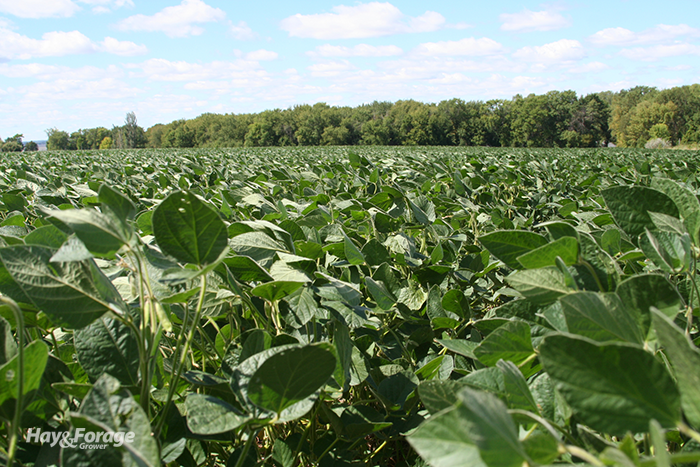
Making soybean hay or silage is one way to combat drought conditions that thwarted a good grain harvest and limited the production of other forages. In fact, soybeans were first domesticated for forage use in the U.S. before farmers discovered their value as an oilseed crop. Cutting, drying, and storing soybean hay or silage can be a finicky process, though, and it will likely take more effort than what it’s worth.
Ohio is one state in particular that has experienced extensive drought conditions this summer. Jason Hartschuh with Ohio State University Extension says harvesting soybeans as an emergency forage is an option, but there are several challenges to consider.
Herbicide and insurance
The greatest limitation of soybean hay or silage is that few herbicides are approved for forage use. If farmers sprayed fields that were originally planted for grain harvest, baling or chopping soybeans might not be legal.
One herbicide in particular, Liberty, specifically prohibits grazing or cutting affected crops for forage. Other products like Dual, Roundup, Prowl, and metribuzin-containing herbicides do allow for forage use as long as farmers adhere to the preharvest interval listed on the label.
The next concern is crop insurance. Talk to your agent to ensure harvesting soybeans will not interfere with your policy. Some policies permit soybean hay or silage harvest — similar to corn silage harvest — but a yield appraisal must be completed before cutting to determine if there is enough loss to trigger your policy coverage.
Cutting and drying
Once herbicide restrictions and crop insurance hurdles are cleared, harvesting soybeans at the proper maturity and moisture level will likely be a challenge. Hartschuh recommends cutting soybeans when pods are filled and the lower leaves are starting to turn yellow, or just before R7. Soybeans harvested after this point will have a greater oil content, which will interfere with ensiling.
A mower-conditioner will help expedite dry down and promote a more even drying rate between leaves and stems. For silage, target 65% to 70% moisture before chopping soybeans. For baleage, wait until forage is 40% to 60% moisture. Hartschuh suggests wrapping bales with six to eight layers of plastic to ensure soybean stems don’t pierce through.
Attempting to make dry soybean hay is not recommended for several reasons, including cumbersome drying conditions, extensive leaf loss during baling, and issues with oil content.
“Dry soybean bales are often dusty and the stems are brittle, decreasing forage consumption and increasing feedbunk refusals,” Hartschuh explains. “The seeds may still contain too much moisture when the plant is dry and may mold in the dry hay. If soybeans are harvested as dry hay, they need to be harvested at R1,” he asserts.
Poor palatability
Although soybean silage can be high in protein and low in fiber, it is not very palatable to livestock. Mixing soybean hay silage with corn silage or low-quality grass hay can improve its palatability, but this requires the use of a bale chopper or a total mixed ration (TMR) mixer.
Hartschuh recommends testing forage before mixing to analyze its feed value and to determine the best ratio of soybean silage to corn silage or grass hay. The extension field specialist also recommends monitoring the oil content in soybean silage to prevent digestive issues in livestock.
Despite mixing forages, lower palatability will likely result in reduced feed value per ton. Farmers should assess soybean yields and compare estimated returns for forage versus grain. For example, current soybean prices are around $9.45 per bushel in Ohio, and alfalfa-grass hay prices post a wide range between $140 and $385 per ton. If soybean grain yields are at least 28 bushels per acre, Hartschuh purports forage yields must be at least 2 tons per acre to justify the latter harvest.

